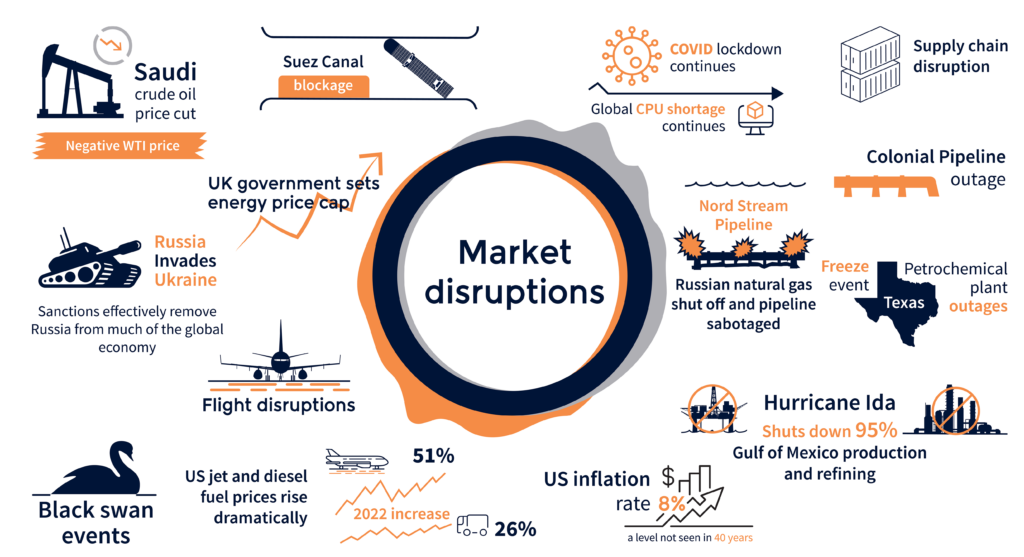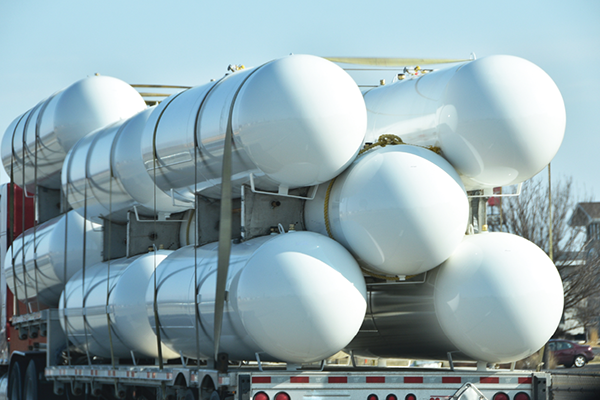Are you equipped for reoccurring commodity market disruptions?
Disruptions are happening with increasing frequency in today’s commodity markets. Multiple “once-in-a-lifetime” events in a single year are becoming commonplace. Consider what has happened since the beginning of 2020:

2020
March: Saudi crude oil price cut drove crude prices down 34% in one day.
March: COVID lockdowns, some of which continue today in regions of China.
April: WTI prices go negative and oil producers reconsider benchmark prices.
October: Global CPU shortage that continues today.
2021
February: The Texas Freeze causes power to go to $9,000 MWh.
February: Petrochemical plant outages extended due to The Texas Freeze.
March: Suez Canal blockage impacts global shipping for several weeks.
May: Colonial Pipeline outage reduces fuel supplies for US Eastern Seaboard.
July: Supply chain congestion in California ports, which continued into 2022.
August: Hurricane Ida shut down 95% of production and refining in the Gulf of Mexico.
2022
February: Russia invades Ukraine, initiating a war that is ongoing today.
March: Sanctions effectively remove Russia from much of the global economy.
April: US inflation rate tops 8%, the highest level in 40 years.
June: US diesel and jet fuel prices hit all-time highs, up 26% and 51% respectively for 2022.
July: Widespread flight disruptions in the US and Europe.
September: Russia cuts off gas flows to Europe on the Nord Stream gas pipeline.
September: Nordstream Pipeline is sabotaged following multiple explosions.
October: Keystone pipeline leak strands crude oil in North Dakota and Canada.
December: Russian crude oil and refined products sanctioned, with exports to Europe, US, and UK almost completely halted.
2023
February: Earthquakes in Türkiye close the major export terminal for Azeri crude oil for one week.
March: Silicon Valley Bank fails, with repercussions throughout the US banking and tech industries.
Until recently, it would have been unusual to see even two of these disruptive events in a 3-year period. However, these events now occur multiple times a year, and being unprepared for such events can put your business at risk. This article explains why these events will continue and how you can mitigate the impact of such events.
Reasons why commodity market disruptions will continue
There are four primary reasons why disruptive events will continue to impact commodities markets significantly:
- Commodity proliferation: The energy transition is bringing new products onto the marketplace. Where once there were only fossil fuels, there are now also 100% renewable fuels, and a multitude of renewable/fossil fuel blends. This complicates supply chains and inventory management significantly. It also and strains supply chains and storage assets, as these products must be stored and transported separately before blending. Moreover, renewable fuel regulations and certificates add additional financial products and complications, making it difficult to substitute products during a disruption.
- Lean supply chains: Years focused on just-in-time delivery have left global supply chains very lean; many would say too lean. With little inventory on hand, a disruption of even a few days can shut down production lines, leaving suppliers unable to meet obligations. In the event replacement products are available, transportation may become the issue. This is because logistics assets are also limited and fully utilized. Supply chains have also become more interconnected. For example, a bad corn crop or corn supply chain issue can have a huge impact on US gasoline prices, because most US gasoline now includes corn ethanol .
- Investment shortfalls: Crude oil and natural gas consumption will continue to grow into the next decade, even under the most optimistic energy transition models. Despite growing demand, investments in fossil fuels are not sufficiently high to sustain the current production, much less meet inevitable demand growth. Investments in oil and gas exploration and production alone would have to increase by more than 100% above current levels, just to sustain 2023 or 2024 demand levels.Also, investments in energy transition activities, like the move to biofuels, often decrease refining and storage capacities for fossil fuels when assets are converted. Although investment is flowing into energy transition activities at record rates, current levels are far below public policy demands. Just meeting current EV and electrification demands for the US, EU, and UK will require global mining to grow to an unprecedented 300% to 1,000% over current levels.With investment shortfalls, the market will continue to be undersupplied for fossil fuels, energy transition fuels, minerals, and metals. With short supplies, any disruption can increase global prices significantly.
- Geopolitical factors: The world’s economy is now more interdependent than ever; events in a single country can impact countries worldwide. Witness the Ukraine War, where the conflict between Russia and Ukraine is felt across the globe due to the war’s impact on exports, and the economic sanctions against Russia. As the world’s largest commodity exporter, the sanctions against Russia have impacted agriculture, crude oil, metals, natural gas, and refined products markets, worldwide.
As a Cold War reemerges between NATO and Russia over Ukraine, another Cold War of possibly even greater consequence is emerging between China and the US and US aligned Pacific Rim countries. These hot and cold wars can impact supply chains and markets for many years, and we are only now experiencing the initial stages of impact.
For the above reasons, it is certain that major market disruptions will continue to occur. They could even accelerate as we move further into the energy transition with its greater complexity and capital expenditures falling short for both fossil fuels and energy transition activities.
Mitigating market disruptions’ impact
The market disruptions impacting the entire commodity industry acutely affect crude oil, refined products, and NGL supply chains, prices, price volatility, and profits. How can you manage the impacts of these events when they occur?
The answer is a commodity management solution (CMS). While these systems cannot prevent most market disruptions, they can significantly mitigate the disruptions’ impact and even lead to opportunities, like gaining market share when you have products that competitors do not. Trying to manage today’s commodity markets with spreadsheets or old legacy systems is problematic on regular days and, during a disruption, can put you out of business. By utilizing a commodity management solution (CMS), you can follow the five steps listed here when dealing with a major market disruption:
- Quickly analyze commodity inventories: The first step in evaluating the impact of a disruption is to determine what you have and where you have it. You need to assess your product inventory and capacity by location and determine existing and expected product imbalances by location.
- Analyze commodity movements: It is critical to quickly identify movements impacted by the disruption to determine if products must be rerouted or if they are at risk of being stranded or lost. If products must be rerouted to sustain product flows, new movements are required, and the costs of alternative routes must be considered. In some cases, events like weather or conflicts will impact consumption patterns and require products to be diverted to entirely new locations where demand is still present.
- Analyze risk and P/L: The disruption will in no doubt introduce price volatility and impact exposure, mark to market (MTM), value at risk (VaR), and profit and loss (P&L). You need to determine not only the current, but the expected future impacts of the disruption. It is also important to look at both the expected change and the rate of change in commodity prices and transportation costs to assess their expected impact on risk and P&L.
- Optimize trading and scheduling decisions: By knowing the disruption’s impact on positions, logistical movements, prices, and P&L, you can make informed decisions on how to reduce the effect of and, if possible, take advantage of the disruption. With visibility into what is affected, you can take targeted actions quickly. Ideally, your product will be on its way before your competitors have even determined how to respond. Finally, the rate of change determines the time available for a decision. If rates are going up only a few percent, you might be able to spend a few days on analysis or wait to see if the problem clears up quickly. Conversely, if the rate of change seems to be heading to 100% in a single day, you might have only hours to decide.
- Assess the impacts of those decisions: After making decisions related to a disruptive event, it is critical to determine the costs and benefits of those decisions. In the worst case, it can provide justification for declaring force majeure. In the best case, it can show how market share was gained because the organization had a product when others did not. In most cases, it will quantify any increased costs or lost revenue and what the impacts would have been if mitigating actions had not been taken. In all cases, analyzing the mitigation measures results in better communication with stakeholders and leads to better future decision-making.
Many of these steps, like number 3, would be almost impossible without a good CMS. That’s because a good CMS enables you to follow the steps more quickly and gives you a better understanding of the costs and tradeoffs of your options. A CMS also allows scenario planning to prepare for disruptions before they even occur.
In almost all cases, following these steps will reduce the costs and other negative impacts of a major disruption, and in some cases, you may even gain market share or see other benefits. Trying to manage such events via spreadsheets or old legacy systems, especially in businesses like crude oil or refined products and fuels, where complexity across the business is increasing dramatically, is very risky. Not improving your systems will result in more reactive decisions and higher-cost structures. In the worst case, you may not be able to continue operations or meet contractual obligations.
An ION CMS equips you to manage market disruptions better
ION Commodities is the leading provider of energy and commodity management solutions to organizations of all sizes across all industries, commodities, and regions. ION understands that no two companies are the same and offers choices, with a comprehensive portfolio of product solutions to address the breadth and depth of business needs.
ION’s extensive product portfolio equips businesses to address current market dynamics for better control and improved visibility into your commodity business operations and risk with accurate data and insights across one’s supply chain.
ION’s innovative suite of products ranges from packaged, multi-tenant SaaS solutions to highly customizable platforms with advanced functionalities for managing marketing, trading, volatility, risk, inventory, scheduling, actualization, settlement, and invoicing processes. ION also has sophisticated value-added solutions for advanced risk analytics, credit and counterparty management, supply chain optimization, and vessel chartering and operations.

Read the case study
Find out how ION’s commodity trading and supply chain planning solutions helped the customer mitigate market disruptions, optimize operations, and outperform competitors.


